My Brother Fathers Remembered
Monday, June 16, 2008
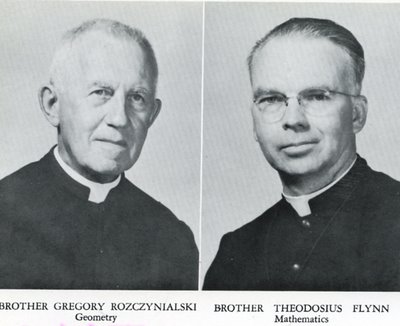
As I write this, 11:15 Sunday night it is still father's day. I have been thinking about it all day. In the afternoon the Waterhouse-Haywards (Rosemary and I ) and the Stewarts (Hilary, Bruce, Lauren, Rebecca and the grandparents Nana and Doug) we all had chicken at my favourite place, Nando's on 41st. I was sitting in a corner so I had time to think.
I wrote about my father and the little I knew him here and here.
In 1957 when I finished grade 8 in Nueva Rosita, Coahuila Mexico my mother had few options. She could send me to the conventional state schools. But my mother wanted the best for me so she decided to send me to the nearest boarding school in the US. That happened to be St. Edwards in Austin, Texas.
Little I was to know when I arrived ( I remember crying I missed my mother so much) that I was going to have many surrogate fathers who would each teach me something of value and in such a way that somehow I would grow up to be of some use to society without too many complexes as baggage. In no special order here they are.
Brother Gregory and Brother Theodosius
It is appropriate that Brother Gregory and Brother Theodosius (photo above, left) sit side by side in my 1960 Edwardian (the name of our yearbook). I never got to know them well because I only had them as teachers and I never dealt with them as dorm prefects, etc. Brother Gregory was always cheerful and warm. From him I learned the perfect beauty of plane geometry and how neat and tidy its two dimensions were. With his class under my belt I was not quie prepared to the cold and precise Brother Theodosious. We were almost afraid of him simply because of his stern face. He never punished us or shouted at us. But then, we never misbehaved. I was able to discern his love for how mathematics worked in an ordered universe. When years later I learned to calculate the volume of a sphere using the calculus I understood (if only for a few seconds) how unimportant our complicated human lives are in comparison to understanding the comparative simplicity of mathematics.
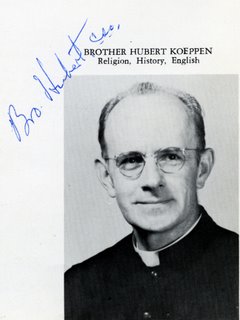
Brother Hubert
Of all the brothers I got to know Brother Hubert most. Besides teaching me ancient history I learned to be frugal. He re-used everything and years later, after he died, they found in his two rooms up the attic of our neo-Gothic building that he had been a prodigious pack rack. Rumours state that there was a fully assembled Model T Ford up there. How did he get it up there? I spent long hours re-winding dance streamers in the school shop that he ran. We chatted. He never gossiped or ever said bad stuff about anybody else. But what he taught me best was to love history and in spite of wars and famine to see the positive. If anything he prepared me to read, comprehend and appreciate the books of Teilhard de Chardin.
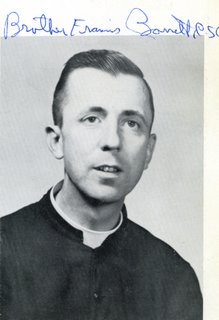
Brother Francis
I have had a bad back for a week and going up and down the stairs is excruciating. I understand now the terrible pain that Brother Francis lived with. He always walked stooped over (even though he was a young man) like Groucho Marx. He looked and talked like a living saint. I don't think I ever saw him lose his temper. He was a living example of absolute equanimity. He taught me American history and he did it with so much passion that to this day I think I have an edge when I read articles in the NY Times about primaries and caucuses. He taught me to be curious about people so that I wanted to read more about them. Brother Francis must have been a lefty because I learned to love President Franklin Delano Roosevelt. And I could tell you all about Sacco and Vanzetti, and the Dred Scott Decision.
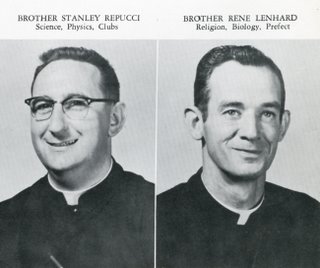
Brother Stanley
From Brother Stanley I learned stuff that would probably have landed him in jail because of an SPCA complaint. After all, he devised contests in his biology class where the prize for keeping a dissected frog alive the longest was a box of cigars. I won a box once. His physics class was so difficult that I dropped it. He looked me straight in the face (and when he was serious he was scary) and told me, "It is difficult to quit. But the more you do it the easier it gets. Soon you will be quitting anything and everything that is too hard." I still dropped his class but after that I stuck to my guns with just about everything else. Brother Stanley taught me to be persistent and to love pizza.
Brother Rene
Brother Rene was a brother who never taught me in class since I only had him as dorm prefect in grade 10. He was the one who played classical music (or Amos and Andy) after lights out over the dorm sound system. He wore short Wellington boots with one of his pant legs casually semi tucked in. I thought it very cool so I bought the same boots. I admired his masculinity and of all the brothers at the St Ed's he was my male/father figure role model. We rarely misbehaved because we had a quiet respect for him. He wasn't warm, he wasn't cold. He kept his distance just right.
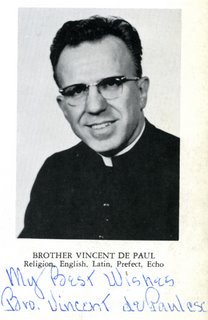
Brother Vincent
I had Brother Vincent for English and as dorm prefect in my grade 9. He was a sculptor so I learned, through his example, to love the arts, specially painting and sculpture. He took our class to Washington DC and I was so struck by its beauty that I have returned many times since.
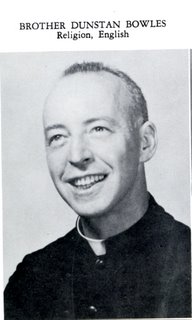
Brother Dunstan
Brother Dunstan was my English and English lit teacher. He was hip. He told us about a young English playwright called Pinter. I love Shakespeare because of Brother Dunstan. Even though he had infinite patience he called me in one day and told me, "Unless you improve your handwriting, which is currently illegible, I will not read your homework assignments anymore." For better or for worse I so admired Brother Dunstan's class that I became an insufferable elitist snob.
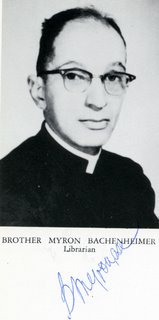
Brother Myron
Brother Myron had a short temper and when he lost it he yelled at us in German. We loved to pick on him (we were very cruel) and see how short his fuse was. But on a one on one basis he was mild, quiet, extremely intelligent and kind. So I went to him and told him about my handwriting problem. Brother Myron told me, "Go and buy an italic nib for your Esterbrook pen and I will teach you how to write legibly." This he did but to an extreme.  I had to buy another pen so I could have two nibs. One was for black ink and one for red ink. The red ink pen I used to write much larger capital letters for the beginning of paragraphs. Brother Myron taught me to make complex capital letters with lots of flourishes. Brother Dunstan gave me A+s for my essays.
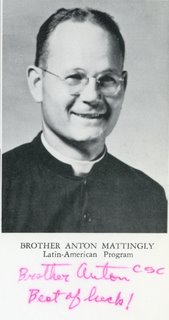
Brother Anton
One year I decided to take Spanish. I was simply lazy. German and Latin involved too much work. Brother Anton taught Spanish and he managed to not be intimidated by the one student in his class who spoke the language perfectly, me. He taught me grammar. My lack of proper grammar meant that when I tried to use logic it failed me as Spanish grammar is not all that logical. Brother Anton had a Pentacon F camera with a F-2 Biotar lens. My Pentacon F with its F-2.8 Tessar lens was a tad inferior. But we compared notes on what in those years, 1956 was a new-fangled type of camera. It was called a single lens reflex.
Brother Edwin
Of Brother Edwin I have written lots here and and here and in many more places but this will suffice. I think that of all the brothers listed here Brother Edwin is the only one who is alive. I correspond with him with frequency.
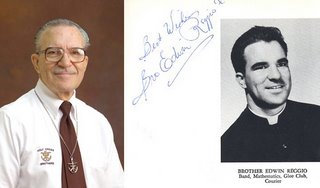
The CBC & The Ties That Bind Us
Sunday, June 15, 2008
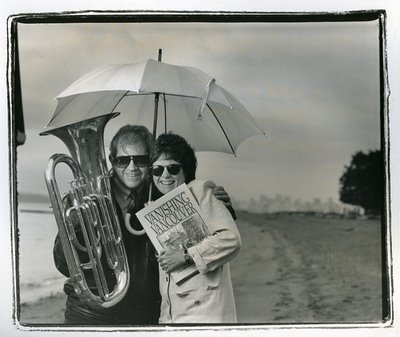
The CBC has not figured in a positive way in a couple of my blogs lately:
1. CBC Vancouver Orchestra.
2. Hockey Night In Canada Theme Song.
But I must attempt to go positive with this broadcasting corporation that has brought me so much pleasure, knowledge, friends and my first photographic job in Canada.
This positive story begins with a positive but negative contribution via an email remark on my Hockey Night In Canada blog. It came from Sharman King (seen here in a photograph I took for Quill & Quire in 1995. I have forgotten who the woman with him is who is holding Michael Cluckner's book.) who is both the owner of The Book Warehouse and a professional musician who plays the trombone and the bass horn for the Vancouver Opera Symphony. Whenever I go to the opera I chat with him when I look down on the orchestra pit. Sharman King is a man with passion for music. And this is what he had to add on Dolores Claman's Hockey Night In Canada Theme Song:
comments:
I don't know if you will remember the original version of
the theme, orchestrated by Dolores' partner Jerry Toth. Arni
Chykoski, who grew up in New Westminster, was the lead
trumpet, arguably the best lead trumpet player in a big band
setting, ever. His last six notes of that original version
were simply stunning in their perfection and ring in my head
to this day.
In their search for a younger demographic (which they will
probably never attract) they're removing many of the ties
that bind us.
Sharman King has found the real reason why I am so upset with all the CBC changes. It is in that last paragraph. But:
When I first started taking pictures of variety shows at the CBC in the mid 70s I felt that I was an outsider as a free lancer. I was not part of an institution. There was no esprit de corps for me and I could not share the complaints (part of that institution!) of my new CBC friends about the "mother corporation". But friends like cameraman Michael Varga, other cameramen, or employees in lighting and staging made me feel at home. One of the places I felt at home at the CBC was the cafeteria. Through the years many attempts were made to improve the food in spite of the constant jokes about CBC cafeterias in Wayne & Shuster (I was a fan!). The food, at best was adequate. The company was special and the highlight was a Shadbolt triptych mural on the west wall. At first I didn't notice it but with familiarity I began to appreciate is happy colours.
The CBC cafeteria was finally closed and coverted into a radio studio. The Shadbolt vanished. Every once in a while I would ask but I was always given an, "I don't know answer." It may have been either Paul Grant or Michale Juk who passed on my request to the building manager. The man called me one day and took me to a basement where I saw the mural. He explained, "We currently have no room for it and it would be a pity to put in on one our many halways. They are too narrow for anybody to appreciate the mural. Don't worry it's safe with us and as soon as we find space for it, we will put it up. "
In any of the Latinamerican countries I have been in that mural would have ended its days in some executive's living room. It is a relief to be in Canada where there is still some accountability.
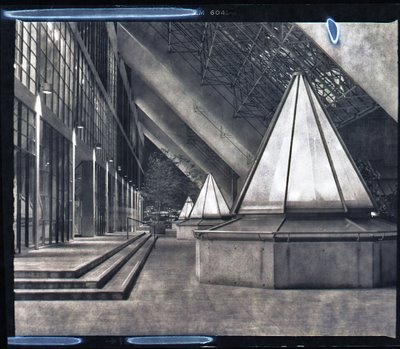
I believe that Vancouver is not kind or respectful to its architects. When the CBC Vancouver building was finished in the 70s it won its architect, Paul Merrick (working for the venerable city firm, Thompson Berwick and Pratt) a Governor General's award. I always liked the building even though many who had to work in it didn't. Now that the building is being "improved" and will have a condo attached to it, I hope room will be found to display that Jack Shadbolt mural. Not only will I smile but I am sure Sharman King will, too.
another Shadbolt.
My Father, Epicene Names - No Saint At Luján
Saturday, June 14, 2008
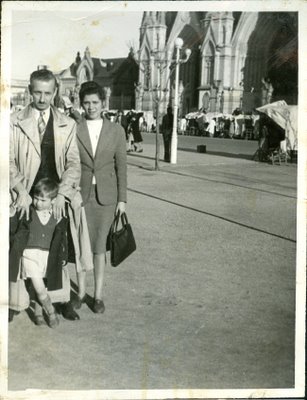 I was with my father for 11 years. I remember few of them as he left home when I was 9 and I only saw him on some weekends. Then when I was 20 I returned to Buenos Aires from Mexico. I had told my mother that I felt patriotic and that I had to serve my country. That's how I ended up as a conscript for the Argentine navy for two years. I never told her that the real reason was that I wanted to find my father. It took a while and I found him. We spent about five month's worth of Sundays before he died. Of these conversations I remember next to nothing. I have always thought I had a good memory but somehow the sinapses here have failed me. Answers to questions which I should have asked have remained unanswered because I never asked them. There is nobody alive now that could answer them for me. Sometime in 1951, when I was 9 I asked my father, "Your favorite books on your book shelf are by Leslie Charteris. Why do you read books written by a woman?" "Sit down, Alex,""he said, "I will explain. Leslie Charteris is a man and his hero is called Simon Templar otherwise known as The Saint. Leslie is an epicene name. This means that it is a name that can be both a girl's or a boy's. If you were called Leslie it would be up to you to make sure everybody knew it was a man's name." When my second daughter was born I insisted that she have an epicene name. So we named her Hilary. Today Rebecca made an apple pie from scratch. I called her up from Safeway and asked her to call me back with the ingredients to buy. Hilary thought this was a project that would be perhaps too tough to handle. Hilary did not count on the fact that Rebecca had observed her make apple pies many times (Hilary's apple pies are famous in our family.) so she knew what to do. We had both Mike Varga (visible in last picture) and Abraham Rogatnick for dinner. The pie was excellent. When I was 8 I distinctly remember helping my father with the making and the cooking of candied (they were green, not red!) apples. I felt so proud and told everybody I had made them. Could this have been the reason why I called Rebecca from Safeway on the apple pie? In the picture above I am with my father and mother outside the neo-Gothic church in Luján in the Province of Buenos Aires. It was taken in 1947 when I was 5.
Friday, June 13, 2008
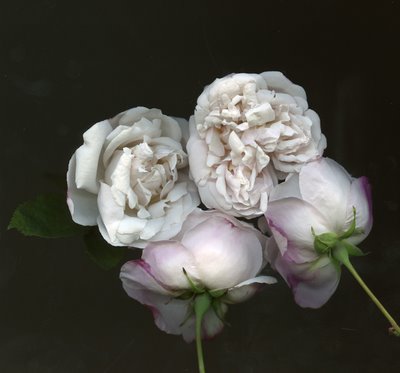 It was sometime around 1977 that I met a beautiful and tiny French Canadian soprano, Ginette Duplessis. I had met her through the Vancouver French CBC Radio station. I wrote about her famous pair and Pernod recipe here. Ginette again was in my memory today. In spite of the cloudy and rainy days a rose that all these years has been most reluctant to do anything except get downy mildew on it leaves finally is blooming as if there were no tomorrow. The rose is extremely rare in our parts. It is Rosa 'Splendens'. It is sometimes called 'Ayrshire Splendens'. This is because these are rambler roses (they bloom once but spread in all directions quite agressively) from a county in south-western Scotland (until the 1890's). This rose has the distinction of being the only rose with a peculiar scent that the English call myrrh. I have written extensively about my fondness for this scent. Here is one occasion. And all the subsequent roses that smell of myrrh somehow must have Splendens in their past. Rosa 'Splendens' came into my garden via Robin Denning and his excellent nursery on Vancouver Island Brentwood Bay Nursery which is not far from the Victoria Ferry terminal. Denning grows roses that only picky people would buy. It was at Brentwood Bay that I found a de-listed (the rose was supposed to get all kinds of diseases) David Austin rose called 'Immortal Juno'. She grows well in my garden and, naturally, is also myrrh scented. It took 10 years for Rosa 'Fantin Latour' to finally bloom as she is supposed to do. She did this last year. It would seem that many roses have an exended childhood and or a long juvenile period. But this year Rosa 'Splendens'is out and when I placed my nose into one of the roses I could smell Ginette Duplessis's pairs!
Not Throwing Up On The Way To An Apollo's Banquet in Lillooet
Thursday, June 12, 2008
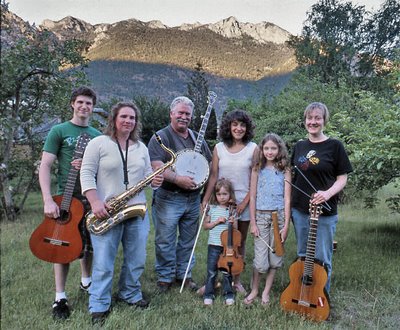 On our way to Lillooet to visit Ale, a couple of weeks ago I got ourselves lost by going straight at Mt Currie instead of turning right at the white church. We arrived at a native Canadian reservation called Darcy and soon a sign said, "road ends in 300 meters". That was exactly the case so by the time we drove back to the white church and then took the right turn we arrived late at Ale's house. The latter part of the journey was not pleasant as Lauren got very sea sick and in complete character decided not to throw up into a plastic bag because, "There is a smell in this bag. And I don't like it." In typical random Ale fashion, ignoring the fact that Rosemary (her mother) likes to arrive and then relax, Ale decided to invite her four musicians friends to greet us with a concert. This was the last possible situation that Rosemary would want. We arrived and the musicians were there. To make it worse Ale told us that everybody was staying for dinner. She was going to make quesadillas. But Rosemary noted Ale had no cheese but happily we had brought tortillas the smaller Don Pancho corn tortillas we all really like). The musicians were playing in the unlikely combinatin of a tenor sax, violin (or banjo), two guitars and electric (yes electric) percussion. Greg Mahaits, violin and banjo, had his chair right at the exit from Ale's porch to her back yard. He had the commanding presence of someone who has worked for the railroad for most of his life. I decided then an there to be civil. I was and my reward was a good time of music being played surrounded by the silence of the countryside and a sunset right there by the mountains I could almost touch. Lauren and Rebecca were running around and I understood Ale's inspired decision to have her musician friends over (even if they had to wait because of our two hour late arrival). The music I heard included sounds I had heard an hour before. It was the 17th century music collection from the English Publications of John Playford. The back of the CD ( Apollo's Banquet - John Playford - with David Douglass, violin, Paul O'Dette, theorbo, Andrew Lawrence-King, harp. The CD is one of Rebecca's favourite, specially since she has met Paul Duglass and his soprano wife Ellen Hargis. The back of the CD reads: A 17th century jam session. The ability to improvise was as important to the 17th century musicians as it is to contemporary jazz players. Not only did that remind me of what I was listening to but the music itself sounded very much like some of the "grounds" (variations on a theme) in the CD. I sat down and I had soon forgotten our detour to Darcy. I purposely went out to the back garden to listen to the sounds and then I noticed the glow in the sky. I knew I had to take a picture. In the picture, from left to right: Paul Dickinson, guitar, Kerry Coast, tenor saxophone and guitar, Greg Mahaits,banjo and violin, Lauren Stewart, Alexandra Waterhouse-Hayward, guitar, Rebecca Stewart and Catherine Neumann, guitar and drums. We had ground meat tacos and I made a spicy salsa with tomatoes, serrano peppers, lime, salt and cilantro. It was simply a feast for all the senses, an Apollo's banquet. Addendum: When Kerry Coast (who plays beautifully by ear) tried to accompany the CD, Apollo's Banquet she was unable to. I have since found out from Glenys Webster who told me, "The CD is probably in the pitch A 415Hz while modern pitch is A 440Hz."
Wednesday, June 11, 2008
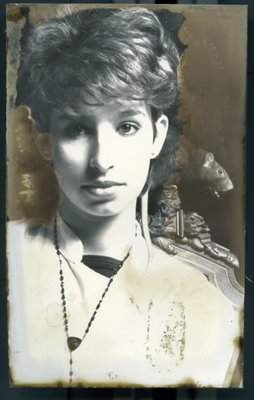 In early 1985 Vancouver Magazine was working on a story on the new but most uncertain coach of the Vancouver Canucks, Bill LaForge. I used to terrorize associate editor, Don Stanley by telling him, "LaForge was fired today, didn't you know?" Since the Vancouver Magazine story had not yet gone to press he would worry about what to do with the story. But it was my joke. As punishment I was dispatched to go to Edmonton to photograph LaForge. The Canucks were playing there one weekend and it would promise to be an interesting game as LaForge was a hometown boy while the Edmonton Oilers with Wayne Gretzky would surely give him a very hot homecoming. And that is exactly what happened. When I showed up at the game my friend CBC sports cameraman Mike Varga whisked me by all the red tape and had me share his booth by the ice. The man sitting on the bench on the other side of my glass was Wayne Gretzky. During one of the intervals (the Canucks were losing miserably) Varga took me to the huge van were one man directed all the cameramen of Hockey Night In Canada. A wall of the van contained multiple TV screens. When the game was renewed (Varga left me in the van) I watched one of the most difficult and perhaps exciting jobs I have ever seen. The director would go from one screen to another and he always seemed to know who had the puck. The job seemed more stressful than being a air traffic controller. I was never able to see a hockey game again without appreciating the difficulty and the resulting expertise of the CBC sports staff. Mike Varga proudly told me, when I mentioned this, "We are the best in the world." I was not yet a Canadian citizen but I was proud. In 1983 I had photographed an extremely beautiful singer, Madeleine Morris in her home on 16th and Granville. I had convinced Les Wiseman who hated synth-pop bands, to write about Morris's band Moev. Morris had a style, a presence and the juiciest mouth I had ever seen. She was tiny and with her short hair and dark but Jewish profile she resembled Nefertiti hooked on cigarettes. I photographed her (above) with her pet rat. Of the rat she told us, "The ordinary rat, the ordinary bubonic plague rat, makes a great pet because you don't have to take them out for walkies." Before I left I was introduced to Morris's charming mother. She was lively and I could see where Madeleine had inherited her feisty talent. Since I have never really been a hockey fan it meant nothing when Morris explained that her mother, Dolores had composed the theme music for Hockey Night In Canada. I am a Canadian citizen now but I can affirm (boast perhaps?) that I never saw an entire episode of the Beachcombers and I would not recognize Dolores's composition if you played it with others. But I am upset on how the CBC bungled their relationship with Dolores Claman. Without knowing all the details perhaps the CBC was right. But I was happy to hear that CTV has settled with Claman and that the theme song will not be lost. The CBC from its headquarters in Toronto is using the Vancouver technique called slow irrelevance. Witness how the Dal Grauer Substation on Burrard (next to what used to be called the BC Electric, then the BC Hydro and now the Electra building) is being slowly abandoned so that it will become invisible. When the wrecking balls come nobody will notice or care about this Vancouver architectural gem. The same happend to the Georgia Medical Dental Building, the original Eatons, and the second Vancouver Hotel. They all went down with almost no protest. First take away the name of Vancouver from the CBC Vancouver Orchestra. Make it the national CBC Radio Orchestra. Then as a fate accompli inform us, the taxpayers, that the orchestra will be no more after November. For me many of the oldsters on CBC Radio 1 and 2 sounded a bit old, tired and bored. But at least they had attractive and gentle or calming voices. In spite of Shelagh Rogers's loudish laugh she does have a wonderful voice. Even her voice (or her mothers' who had an even better voice) could do no justice or impart any poetry to her replacement's name. These oldsters have been replaced by people with fairly unattractive voices and I find it impossible to spell or pronounce their names. I suspect this is a conservative-getting-old rant on my part! But I used to listen to Katherine Duncan's late night program on Radio 2, "This is Katherine Duncan from Calgary," she would say with a magical voice that almost wanted me to inform wife Rosemary, "I divorce you, here and now, and I am off to romantic and exotic Calgary." Such was the power of Duncan's voice that she made Calgary seem like that exotic destination. Another voice (erudite, too) was Peter Tonye's. While these two will be back on the radio I see the Vancouver irrelevance technique well at play. We oldsters (I am 65) just simply turn of the radio and listen to CDs in the car. I am not sure if the younger generation is all that excited about Grant Lawrence's podcasts or banal programs about what women will be wearing in the street next season. As the CBC sounds more and more like commercial radio, it will fade with the fortunes of other commercial radio stations. Commercial radio has ads. CBC Radio 1 has constant Jian Gomeshi ads. Is there a difference? For me CBC radio has stood out with its uniqueness and not being part of the crowd. When the CBC finally goes off the air I will not care. Will others? Just this once I wish that Toronto had not learned Vancouver's irrelevance trick so quickly and so well. The other side of the story?
Previsualizing The Unpredictable - Minor White
Tuesday, June 10, 2008
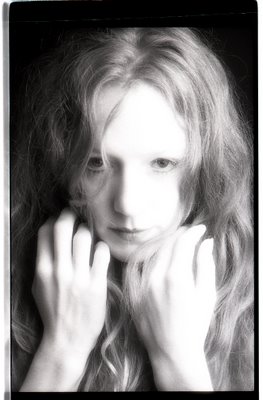
There is a neat little book in my library (printed in 1968) that I look at and read in sections every once in a while. It is a book about a vanishing era of photography. The subject is and was called the Zone System. The man who pioneered most of it was Ansel Adams but the man who wrote about it in a Zen kind of way was the American Photographer and teacher Minor White. Minor White's little book is called Zone System Manual - Previsualization - Exposure - Development - Printing.
Minor White's idea was that you could approach a scene and take a photograph with your mind's eye. If you were really good at it and you had the technical practice then the image in your mind would be realized with camera and film. This was the photographic equivalent of the architect who sees an empty space and can already see the finished building before the cornerstone is laid.
This act of previsualization comes to me infrequently. When it happens it is sheer joy. Sometimes my subject will pose. I will shoot a Polaroid and then a couple of pictures with film and stop. At one time I would take rolls and rolls of film. But in these rare moments one exposure is all I need. I know that the image in my head will be exactly the one on film. Of course the chances of this happening are greater when I reduce the variables such as doing it in my studio, using a specific light I am comfortable with and using a tried and true technique.
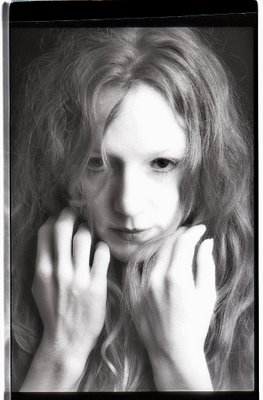
You would think that this predictability could be boring in the end. Consider what Minor White says in his introduction:
The ultimate objective is to be able to previsualize as one wishes, spontaneously or leisurely whichever best serves the purposes at hand. There is a difference in the penetrating power of an image made in a burst of naive enthusiasm and those made in a flash of trained intuition. The first is adolescent, the latter mature and sometimes wise.
Minor White then eloquently writes on the subject of previsualization and the development of intuition:
Photography serves all kinds of image-making talent in mankind wiht an equality that almost amounts to an holy indifference. It does not distinguish the sleeper from the trancendentalist; it serves the first with its automatic mechanicalness, the second with its power to evoke th sense of light in images. It gives the spark of creativity in anyone a fine chance to grow. And from those people who have grown to love photography and master it have come three psychological concepts: Equivalence (Alfred Stieglitz), Previsualization (Edward Weston and Ansel Adams) and Response. )( The latter sometimes goes under the name of "reading photographs".) These concepts give affirmation to individuals who pursue consciousness and wakefulness by way of photography.
Forty years ago a Mexican chemical engineer, radio station owner and amateur photographer, Ingeniero Luis de la Rosa took me under his wing and revealed to me The Zone System. We photographers who have at the very least a minimum understanding of it (that's me) will always capitalize it (The Zone System!) on principle. It was de la Rosa who taught me to use a hand held light meter in the incidence mode (measuring the light that falls on the scene) as opposed to the usually inaccurate reflected mode (it measures light bouncing off from our scene).
One day, I remember it so vividly that I know we were having coffee in the Sanborns on Calle Amberes in Mexico City, de la Rosa handed me a yellow box of Kodak b+w infrared film. His instructions were as follows:
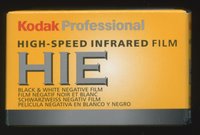
1. Don't open the container except in absolute darkness.
2. Load it into your camera in absolute darkness.
3. Expose it using a No 25 deep red filter.
4. Infra red light focuses at a different wave length so when you focus with your lens then "unfocus" to the little red mark on your lens's focusing ring.
5. Remove the film only in darkness.
6. Develop it in Kodak HC-110. If this developer was good enough for Ansel Adams it should be good enough for you.
Of course I didn't follow the man's advice and I opened the container during the day. Light slipped in and fogged the film. I had to start again. But once I had gotten the hang of it I was rewarded by exposures that were not always predictable. And every once in a while serendipity gave me completely unplanned yet wonderful shots. Infra red film is a grainy film which reacts to objects, plants and people in how much infrared light they reflect. Deciduous tree leaves will photograph a startling white. Blue skies and white clouds will look like a b+w Randolph Scott western, nuit américaine, day for night.
But it is in shooting nudes and portraits that infrared film becomes a constant and almost unpredictable surprise. I am sure that Minor White might have modified his little book to include infrared film. He had that mystical connections. We mortals simply have to adjust to its randomness. It was infrared film that made Lauri Stallings look like she was jumping in the air when she was really sitting on a stool.
One predictable result of using infrared film is that anything red always appears much lighter or white. This means that lips in portraits appear white and my subjects might look dead, or worse, undead. The solution is to use purple lipstick. Since purple is in the opposite end of colour spectrum it renders dark. I have been looked at strangely at London Drugs the times I have gone to the makeup counter to ask for purple lipstick.
The single most unpredictable variable in using infrared film is the way that my flash's catch-lights might not appear reflected on my subject's eyes. It seems to depend on certain angles (the angle between the light and the elevation of the eyes) that only de la Rosa might have explained to me. As example I show here one exposure of Lauri Stallings scanned in three different ways. The images range from angel to witch. Of course infrared film renders Stallings's hair as near white. In this third version I colourized to increase the idea of the witch and to remove it as far from the first image of the angel.
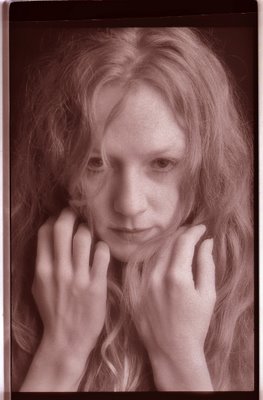
Kodak recently discontinued its infrared film. I have a few boxes in my freezer. Then I discovered that my Corel Paint Shop Pro X photo program has an uncanny conversion of b+w to b+w infrared. It is so good that it manages to look more like infrared film than authentic infrared film. You are now able to previsualize a scene or portrait and get what's in your mind every time.
At least that's what I thought. But notice in the above three photographs the curious look in Stallings's eyes. Then look at the picture below (left) which is standard b+w and then a Corel Paint Shop Pro X modified to look like infrared (below, right). There is something missing in the eyes.
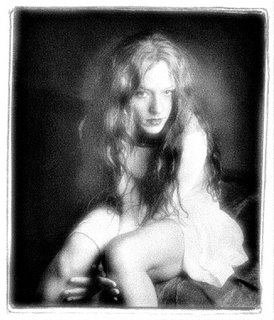
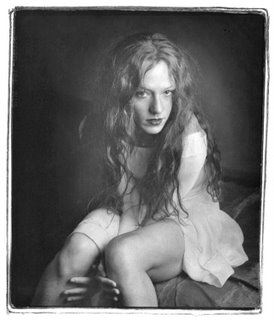
Compare those two (I am satisfied with the normal b+w version on the left) with the true infrared below. I think that while previsualization is a good thing it is so much fun to be surprised!
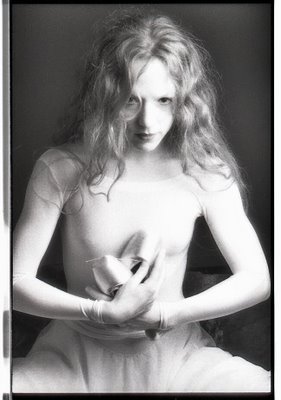
|







 I had to buy another pen so I could have two nibs. One was for black ink and one for red ink. The red ink pen I used to write much larger capital letters for the beginning of paragraphs. Brother Myron taught me to make complex capital letters with lots of flourishes. Brother Dunstan gave me A+s for my essays.
I had to buy another pen so I could have two nibs. One was for black ink and one for red ink. The red ink pen I used to write much larger capital letters for the beginning of paragraphs. Brother Myron taught me to make complex capital letters with lots of flourishes. Brother Dunstan gave me A+s for my essays.




















